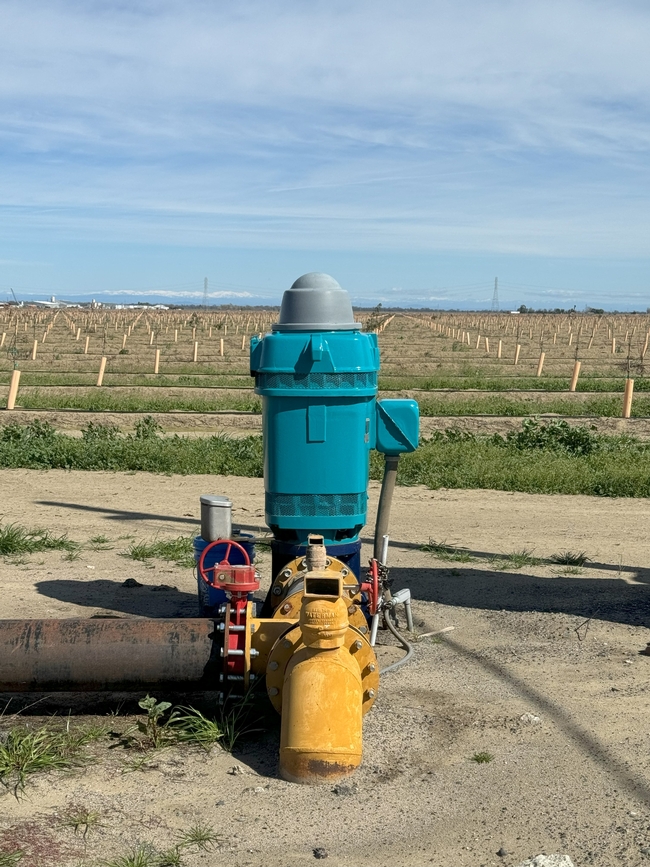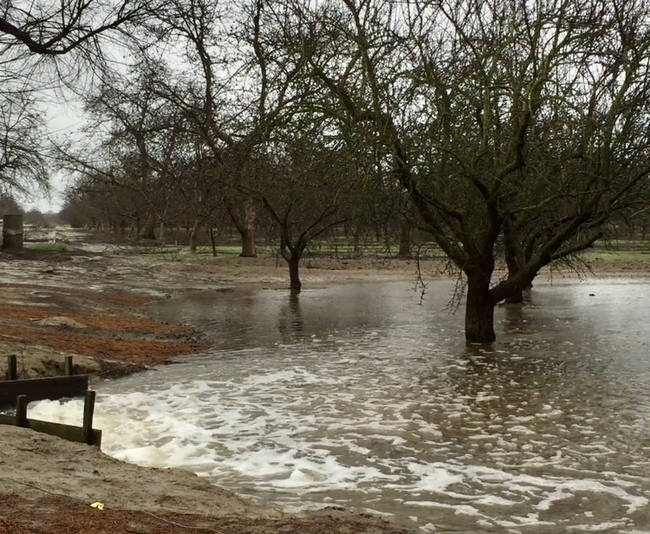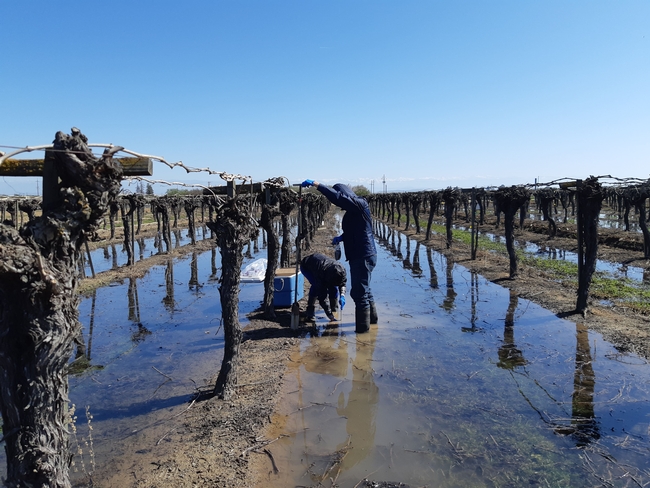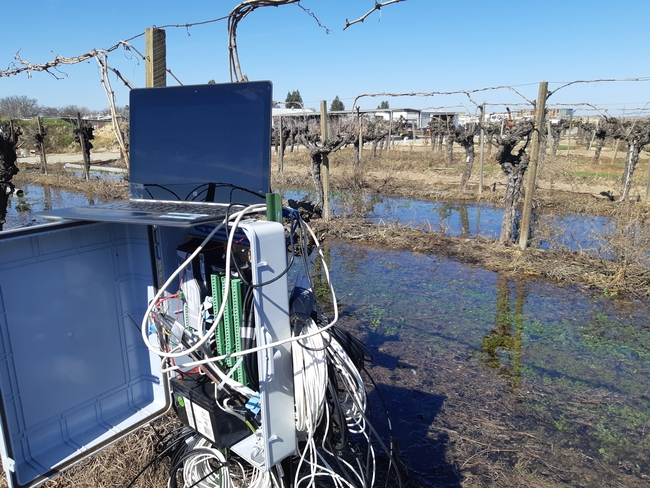Posts Tagged: groundwater
Lawn-pocalypse! Surviving Drought
Ah, summer! The season of sunburns, pool parties, and… lawn droughts. If your once lush, green carpet now looks like a crunchy brown doormat, you're not alone. Let's dive into why your yard is staging a dramatic death scene and what you can do to...

Bermuda grass and weeds overtaking drought stressed turf grass.
Groundwater demand management subject of discussions June 17
Groundwater demand management in agricultural regions is the focus of a workshop that will be held June 17, from 9 a.m. to 3:30 p.m., at the Hyatt Regency San Francisco Airport in Burlingame.
Representatives of groundwater sustainability agencies (GSAs), water districts, irrigation districts, government agencies, environmental justice organizations and the private sector and growers and researchers will discuss groundwater demand management from their own perspectives.
“Speakers will discuss policy development, stakeholder engagement and funding considerations for groundwater demand management,” said workshop co-organizer Isaya Kisekka, UC Davis professor of hydrology and agricultural water management and director of UC Davis Agricultural Water Center. “Participants also will discuss available tools and technologies for implementation and monitoring of groundwater demand management programs.”
The agenda is posted at https://ucanr.edu/sites/groundwaternitrate/files/398036.pdf.
Registration for the workshop is free. Register at Groundwater Demand Management Workshop Registration.
This is one of three free workshops – managing groundwater nitrate, groundwater demand and groundwater governance – being offered before the "Toward Sustainable Groundwater in Agriculture - Linking Science and Policy" conference June 17-20 https://ag-groundwater.org.
New database helps Californians understand proposed groundwater plans
Sustainable Groundwater Management Act allows for flexibility in local conservation strategies
To achieve groundwater sustainability under California's Sustainable Groundwater Management Act, or SGMA, demand management – policies that encourage water conservation – will be necessary, says Ellen Bruno, University of California Cooperative Extension specialist in quantitative policy analysis at UC Berkeley.
A key feature of the state's approach to SGMA is that local groundwater sustainability agencies can develop their own plans for achieving sustainable groundwater use, allowing for local flexibility and experimentation.
Reflecting the open-ended nature of the law, Groundwater Sustainability Plans across the state include a variety of water conservation strategies. Many, but not all, GSPs include tools such as allocations, taxes or fees, pumping restrictions, or efficiency incentives. Understanding these policy choices is important because they will influence the economic costs of SGMA.
To help people understand groundwater sustainability plans for their area, Bruno and UC Berkeley Ph.D. student Arthur R. Wardle have created a database. They record and explain the demand management proposals made in the state's 118 submitted groundwater sustainability plans and make these data publicly available in a new online platform called the SGMA Demand Management Action Database (SGMA-DMAD.com).
“The site allows for bulk download of the data we collected,” Wardle said. “Users can also locate a specific groundwater sustainability agency on a map of California to see what demand management strategies that agency is proposing.”
The Demand Management Action Database is the first easily navigated collection of the demand management strategies being proposed across California.
Many GSPs include over 1,000 pages, reflecting the many criteria they are required to satisfy. Among these pages are discussions of hydrogeologic features of the relevant groundwater subbasin, projections of future water demands and supplies, water budgets and other information necessary for the development of an effective management plan. Only one small section of the GSP, usually taking up only about a dozen pages, explains the management actions the agency is proposing to achieve sustainability.
“GSPs are an imperfect guide to what will actually happen as groundwater agencies implement SGMA,” Bruno said. “The plans laid out in GSPs are subject to change. However, submitted GSPs are the best publicly available evidence of what steps groundwater sustainability agencies plan to take in meeting their SGMA obligations.”
GSPs often distinguish between plans that will definitely be undertaken and plans that are provisional, subject to external approvals, need for additional funding, or are simply being left in the planning stage due to uncertainty over future water needs. The Demand Management Action Database includes information distinguishing between plans that are or will be implemented, versus those that remain uncertain.
“Some plans are still undergoing review and approval from the state,” Bruno said. “But even for the plans that have been approved, they have until 2040 to actually achieve their sustainability goals – or 2042 for basins not in critical overdraft – so I'm sure there will be adjustments to these proposals over time.”
In evaluating the role of demand management in submitted GSPs, the authors categorized demand management actions into a few broad categories – allocations, taxes/fees, pumping restrictions and efficiency incentives – each with a good deal of variation within them.
For each GSP, the Demand Management Action Database shows whether some policy fitting into each of these buckets is discussed in the GSP, along with details and page numbers for people wanting to know more about how a specific GSP is implementing each policy.
For those wanting to conduct their own analysis, the site also includes a download button enabling the entire database to be accessed at once. This data is free to use with proper citation.
Anyone interested in SGMA governance is invited to explore the site and send questions, comments or concerns to Arthur R. Wardle at arw@berkeley.edu.
Climate-Change Resources
University of California UC ANR Green Blog (Climate Change and Other Topics) https://ucanr.edu/blogs/Green/index.cfm?tagname=climate%20change (full index)
Examples:
- Save Trees First: Tips to Keep Them Alive Under Drought https://ucanr.edu/b/~CdD
- Landscaping with Fire Exposure in Mind: https://ucanr.edu/b/~G4D
- Cities in California Inland Areas Must Make Street Tree Changes to adapt to Future Climate https://ucanr.edu/b/~oF7
Drought, Climate Change and California Water Management Ted Grantham, UC Cooperative Extension specialist (23 minutes) https://youtu.be/dlimj75Wn9Q
Climate Variability and Change: Trends and Impacts on CA Agriculture Tapan Pathak, UC Cooperative Extension specialist (24 minutes) https://youtu.be/bIHI0yqqQJc
California Institute for Water Resources (links to blogs, talks, podcasts, water experts, etc.) https://ciwr.ucanr.edu/California_Drought_Expertise/
UC ANR Wildfire Resources (publications, videos, etc.) https://ucanr.edu/News/For_the_media/Press_kits/Wildfire/ (main website)
-UC ANR Fire Resources and Information https://ucanr.edu/sites/fire/ (main website)
-Preparing Home Landscaping https://ucanr.edu/sites/fire/Prepare/Landscaping/
UC ANR Free Publications https://anrcatalog.ucanr.edu/ (main website)
- Benefits of Plants to Humans and Urban Ecosystems: https://anrcatalog.ucanr.edu/pdf/8726.pdf
-Keeping Plants Alive Under Drought and Water Restrictions (English version) https://anrcatalog.ucanr.edu/pdf/8553.pdf
(Spanish version) https://anrcatalog.ucanr.edu/pdf/8628.pdf
- Use of Graywater in Urban Landscapes https://anrcatalog.ucanr.edu/pdf/8536.pdf
- Sustainable Landscaping in California https://anrcatalog.ucanr.edu/pdf/8504.pdf
Other (Non-UC) Climate Change Resources
Urban Forests and Climate Change. Urban forests play an important role in climate change mitigation and adaptation. Active stewardship of a community's forestry assets can strengthen local resilience to climate change while creating more sustainable and desirable places to live. https://www.fs.usda.gov/ccrc/topics/urban-forests
Examining the Viability of Planting Trees to Mitigate Climate Change (plausible at the forest level) https://climate.nasa.gov/news/2927/examining-the-viability-of-planting-trees-to-help-mitigate-climate-change/
Reports and other information resources coordinated under the auspices of the United Nations and produced through the collaboration of thousands of international scientists to provide a clear and up to date view of the current state of scientific knowledge relevant to climate change. United Nations Climate Action
Scientific reports, programs, action movements and events related to climate change. National Center for Atmospheric Research (National Science Foundation)
Find useful reports, program information and other documents resulting from federally funded research and development into the behavior of the atmosphere and related physical, biological and social systems. Search and find climate data from prehistory through to an hour ago in the world's largest climate data archive. (Formerly the "Climatic Data Center") National Centers for Environmental Information (NOAA)
Think tank providing information, analysis, policy and solution development for addressing climate change and energy issues (formerly known as the: "Pew Center on Global Climate Change"). Center for Climate & Energy Solutions (C2ES)
Mapping Resilience: A Blueprint for Thriving in the Face of Climate Disaster. The Climate Adaptation Knowledge Exchange (CAKE) was launched in July 2010 and is managed by EcoAdapt, a non-profit with a singular mission: to create a robust future in the face of climate change by bringing together diverse players to reshape planning and management in response to rapid climate change. https://www.cakex.org/documents/mapping-resilience-blueprint-thriving-face-climate-disaster
Cal-Adapt provides a way to explore peer-reviewed data that portrays how climate change might affect California at the state and local level. We make this data available through downloads, visualizations, and the Cal-Adapt API for your research, outreach, and adaptation planning needs. Cal-Adapt is a collaboration between state agency funding programs, university and private sector researchers https://cal-adapt.org/
Find reports, maps, data and other resources produced through a confederation of the research arms of 13 Federal departments and agencies that carry out research and develop and maintain capabilities that support the Nation's response to global change. Global Change (U.S. Global Change Research Program)
The Pacific Institute is a global water think tank that combines science-based thought leadership with active outreach to influence local, national, and international efforts to develop sustainable water policies. https://pacinst.org/our-approach/
Making equity real in climate adaptation and community resilience policies and programs: a guidebook. https://greenlining.org/publications/2019/making-equity-real-in-climate-adaption-and-community-resilience-policies-and-programs-a-guidebook/
Quarterly CA Climate Updates and CA Drought Monitor Maps (updated each Thursday) https://www.drought.gov/documents/quarterly-climate-impacts-and-outlook-western-region-june-2022
Study offers insights on reducing nitrate contamination from groundwater recharge
Light irrigation before flooding stimulates microbes to remove nitrates from soil
With California enduring record-breaking rain and snow and Gov. Gavin Newsom recently easing restrictions on groundwater recharge, interest in “managed aquifer recharge” has never been higher. This process – by which floodwater is routed to sites such as farm fields so that it percolates into the aquifer – holds great promise as a tool to replenish depleted groundwater stores across the state.
But one concern, in the agricultural context, is how recharge might push nitrates from fertilizer into the groundwater supply. Consumption of well water contaminated with nitrates has been linked to increased risk of cancers, birth defects and other health impacts.
“Many growers want to provide farmland to help recharge groundwater, but they don't want to contribute to nitrate contamination of the groundwater, and they need to know how on-farm recharge practices might affect their crops,” said Matthew Fidelibus, a University of California Cooperative Extension specialist in the UC Davis Department of Viticulture and Enology.
A recently published study by UC scientists sheds new light on how nitrates move through an agricultural recharge site and how growers might reduce potential leaching. Researchers analyzed data from two grapevine vineyards at Kearney Agricultural Research and Extension Center in Fresno County – one flooded for two weeks, and other for four.
Understanding initial nitrate levels crucial
A key factor in mitigating contamination is understanding how much nitrate is in the soil at the outset, said study author Helen Dahlke, a UC Davis hydrologist and leader of UC Agriculture and Natural Resources' strategic initiative on water. In areas with little precipitation and cropping systems that require greater amounts of synthetic fertilizer, the accumulation of residual nitrate – resulting from nitrogen in the fertilizer not taken up by the plants – can be quite high.
“The percentage of nitrates in some soils can really increase over the years, particularly if you have many dry years in a row where you don't have access to irrigation water or natural precipitation flushing some of those nitrates out of the soil,” Dahlke said.
While intense rains in recent weeks have helped dilute nitrate concentrations naturally, farmers looking to participate in recharge during the dry years ahead should consider flooding their fields with greater volumes of water.
“If you're doing this for the first time – on-farm recharge in the winter – check your residual soil nitrate levels because if they're very high, you should apply a lot of water in order to make sure that the residual nitrate is diluted down,” said Dahlke, who also added that growers should check their soil properties for suitability of recharge projects.
She recommended using, as a “good first approximation,” the online Soil Agricultural Groundwater Banking Index map, a project led by Toby O'Geen, a UC Cooperative Extension soil resource specialist.
Researchers looking at other ways to reduce nitrates
Even before flooding the fields for recharge, there are several practices that can lower initial nitrate levels and risk of leaching. Cover crops such as alfalfa and triticale, for example, can help take up residual nitrates that accumulate from fertilizing a main crop over time.
Dahlke and Fidelibus – a co-author of the San Joaquin Valley vineyard study – both pointed to pre-flooding irrigation that encourages denitrification, a process in which soil microbes transform nitrates into gaseous forms of nitrogen.
“Those denitrifying microbes need to be stimulated to do the work,” said Dahlke. “What we have found is that if you do a little bit of irrigation before you start the flooding, increasing the soil moisture can get those microbes started and they can take out more nitrate from the soil.”
The timing and quantity of fertilizer applications are also major factors in reducing leaching. Although more growers are following high-frequency, low-concentration practices to maximize uptake by crops, Dahlke said there needs to be more emphasis on incorporating nitrogen transformation processes – such as denitrification – in the nutrient management guidelines that farmers follow.
“Implementing thoughtful nutrient management plans will play a particularly important role in participating farms,” Fidelibus added.
A more holistic view of groundwater recharge
In short, choices made during the growing season can affect those in the winter recharge season – and vice versa. For example, applying compost or other organic amendments to soil can give microbes the “fuel” they need for sustained denitrification.
“What we have found is that our denitrifying bacteria often run out of steam because they don't have enough carbon to do the work,” Dahlke said. “Like us, microbes need energy to do the work, and for microbes this energy comes from soil carbon.”
Then, adding moisture via recharge to that field with high organic content can stimulate mineralization and nitrification, processes in which microbes transform the organic nitrogen into ammonium – and subsequently nitrates – that the plants can then take up. Those naturally occurring nitrates would thus reduce the need for the grower to apply synthetic fertilizer.
“The winter on-farm recharge experiments have shown that altering the moisture regime in the winter has consequences for the nitrogen budget in the summer growing season,” Dahlke explained. “Theoretically, what we need to be doing is better integrating both seasons by keeping an eye on the soil-nitrogen balance across the whole year so that we can ensure, at the end of the growing season, the residual nitrate in the soil is minimized.”
The study, published in the journal Science of The Total Environment, was part of the post-doctoral work of former UC Davis researcher Elad Levintal. In addition to Fidelibus and Dahlke, other authors are Laibin Huang, Cristina Prieto García, Adolfo Coyotl, William Horwath and Jorge Rodrigues, all in the Department of Land, Air and Water Resources at UC Davis.





